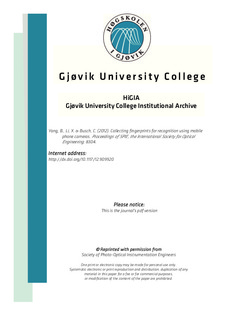| dc.contributor.author | Yang, Bian | |
| dc.contributor.author | Li, Xue | |
| dc.contributor.author | Busch, Christoph | |
| dc.date.accessioned | 2012-05-10T07:54:28Z | |
| dc.date.available | 2012-05-10T07:54:28Z | |
| dc.date.issued | 2012 | |
| dc.identifier.citation | Yang, B., Li, X. & Busch, C. (2012). Collecting fingerprints for recognition using mobile phone cameras. Proceedings of SPIE, the International Society for Optical Engineering, 8304. | no_NO |
| dc.identifier.issn | 0277-786X | |
| dc.identifier.uri | http://hdl.handle.net/11250/142558 | |
| dc.description | This is the copy of journal's version originally published in Proc. SPIE 8304: http://dx.doi.org/10.1117/12.909920. Reprinted with permission of SPIE. | no_NO |
| dc.description.abstract | We present in this paper a sample quality control approach for the case using a mobile phone’s camera as a fingerprint
sensor for fingerprint recognition. Our approach directly estimates the maximum ridge frequency orientation by the
amplitude-frequency features of the Fast Fourier Transform and takes the frequency features’ difference in two
perpendicular orientations as a distinguishing feature for ridge-like patterns. Then a decision criterion which combines
the frequency components’ energy and ridge orientation features is used to determine if an image block should be
classified as high-quality fingerprint area or not. The number of such high-quality blocks can thus be used to indicate the
whole fingerprint sample’s quality. Experiments show this approach's effectiveness in distinguishing the high-quality
blocks from other low-quality ones or background area. Mapping the quality metric to the sample utility as derived from
the the NIST minutiae extractor "mindtct" function is also given to verify the approach's quality prediction effectiveness. | no_NO |
| dc.language.iso | eng | no_NO |
| dc.publisher | Society of Photo Optical Instrumentation Engineers (SPIE) | no_NO |
| dc.subject | fingerprint | no_NO |
| dc.subject | quality assessment | no_NO |
| dc.subject | mobile phone camera | no_NO |
| dc.title | Collecting fingerprints for recognition using mobile phone cameras | no_NO |
| dc.type | Journal article | no_NO |
| dc.type | Peer reviewed | no_NO |
| dc.subject.nsi | VDP::Mathematics and natural science: 400::Information and communication science: 420::Security and vulnerability: 424 | no_NO |
| dc.source.pagenumber | 8 | no_NO |
| dc.source.volume | 8304 | no_NO |
| dc.source.journal | Proceedings of SPIE, the International Society for Optical Engineering | no_NO |
| dc.identifier.doi | http://dx.doi.org/10.1117/12.909920 | no_NO |
